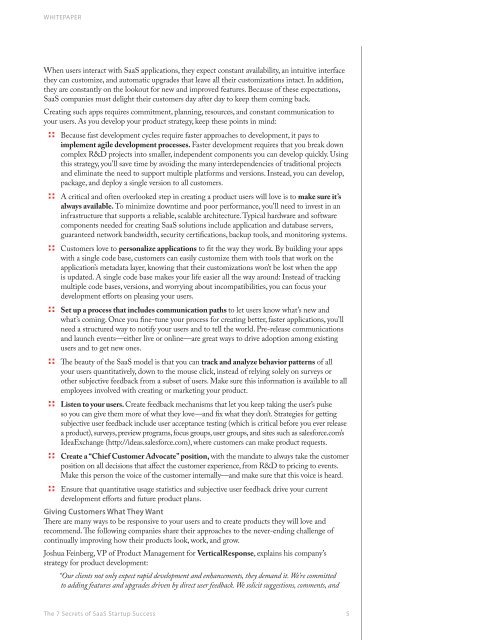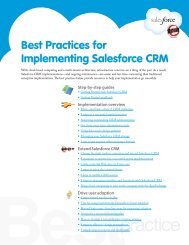The 7 Secrets of SaaS Startup Success - Salesforce.com
The 7 Secrets of SaaS Startup Success - Salesforce.com
The 7 Secrets of SaaS Startup Success - Salesforce.com
Create successful ePaper yourself
Turn your PDF publications into a flip-book with our unique Google optimized e-Paper software.
WHITEPAPER<br />
When users interact with <strong>SaaS</strong> applications, they expect constant availability, an intuitive interface<br />
they can customize, and automatic upgrades that leave all their customizations intact. In addition,<br />
they are constantly on the lookout for new and improved features. Because <strong>of</strong> these expectations,<br />
<strong>SaaS</strong> <strong>com</strong>panies must delight their customers day after day to keep them <strong>com</strong>ing back.<br />
Creating such apps requires <strong>com</strong>mitment, planning, resources, and constant <strong>com</strong>munication to<br />
your users. As you develop your product strategy, keep these points in mind:<br />
:: Because fast development cycles require faster approaches to development, it pays to<br />
implement agile development processes. Faster development requires that you break down<br />
<strong>com</strong>plex R&D projects into smaller, independent <strong>com</strong>ponents you can develop quickly. Using<br />
this strategy, you’ll save time by avoiding the many interdependencies <strong>of</strong> traditional projects<br />
and eliminate the need to support multiple platforms and versions. Instead, you can develop,<br />
package, and deploy a single version to all customers.<br />
:: A critical and <strong>of</strong>ten overlooked step in creating a product users will love is to make sure it’s<br />
always available. To minimize downtime and poor performance, you’ll need to invest in an<br />
infrastructure that supports a reliable, scalable architecture. Typical hardware and s<strong>of</strong>tware<br />
<strong>com</strong>ponents needed for creating <strong>SaaS</strong> solutions include application and database servers,<br />
guaranteed network bandwidth, security certifications, backup tools, and monitoring systems.<br />
:: Customers love to personalize applications to fit the way they work. By building your apps<br />
with a single code base, customers can easily customize them with tools that work on the<br />
application’s metadata layer, knowing that their customizations won’t be lost when the app<br />
is updated. A single code base makes your life easier all the way around: Instead <strong>of</strong> tracking<br />
multiple code bases, versions, and worrying about in<strong>com</strong>patibilities, you can focus your<br />
development efforts on pleasing your users.<br />
:: Set up a process that includes <strong>com</strong>munication paths to let users know what’s new and<br />
what’s <strong>com</strong>ing. Once you fine-tune your process for creating better, faster applications, you’ll<br />
need a structured way to notify your users and to tell the world. Pre-release <strong>com</strong>munications<br />
and launch events—either live or online—are great ways to drive adoption among existing<br />
users and to get new ones.<br />
:: <strong>The</strong> beauty <strong>of</strong> the <strong>SaaS</strong> model is that you can track and analyze behavior patterns <strong>of</strong> all<br />
your users quantitatively, down to the mouse click, instead <strong>of</strong> relying solely on surveys or<br />
other subjective feedback from a subset <strong>of</strong> users. Make sure this information is available to all<br />
employees involved with creating or marketing your product.<br />
:: Listen to your users. Create feedback mechanisms that let you keep taking the user’s pulse<br />
so you can give them more <strong>of</strong> what they love—and fix what they don’t. Strategies for getting<br />
subjective user feedback include user acceptance testing (which is critical before you ever release<br />
a product), surveys, preview programs, focus groups, user groups, and sites such as salesforce.<strong>com</strong>’s<br />
IdeaExchange (http://ideas.salesforce.<strong>com</strong>), where customers can make product requests.<br />
:: Create a “Chief Customer Advocate” position, with the mandate to always take the customer<br />
position on all decisions that affect the customer experience, from R&D to pricing to events.<br />
Make this person the voice <strong>of</strong> the customer internally—and make sure that this voice is heard.<br />
:: Ensure that quantitative usage statistics and subjective user feedback drive your current<br />
development efforts and future product plans.<br />
Giving Customers What <strong>The</strong>y Want<br />
<strong>The</strong>re are many ways to be responsive to your users and to create products they will love and<br />
re<strong>com</strong>mend. <strong>The</strong> following <strong>com</strong>panies share their approaches to the never-ending challenge <strong>of</strong><br />
continually improving how their products look, work, and grow.<br />
Joshua Feinberg, VP <strong>of</strong> Product Management for VerticalResponse, explains his <strong>com</strong>pany’s<br />
strategy for product development:<br />
“Our clients not only expect rapid development and enhancements, they demand it. We’re <strong>com</strong>mitted<br />
to adding features and upgrades driven by direct user feedback. We solicit suggestions, <strong>com</strong>ments, and<br />
<strong>The</strong> 7 <strong>Secrets</strong> <strong>of</strong> <strong>SaaS</strong> <strong>Startup</strong> <strong>Success</strong> 5

















